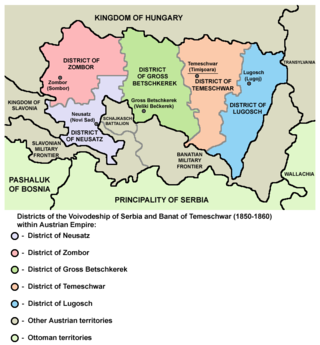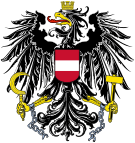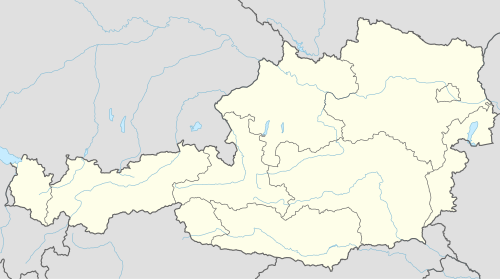
Burgenland is the easternmost and least populous state of Austria. It consists of two statutory cities and seven rural districts, with a total of 171 municipalities. It is 166 km (103 mi) long from north to south but much narrower from west to east. The region is part of the Centrope Project. The name of Burgenland was invented/coined in 1922, after its territories became part of Austria.

Eisenstadt is the capital city of the Austrian state of Burgenland. With a population of 15,074, it is the smallest state capital and the 38th-largest city in Austria overall. It lies at the foot of the Leitha Mountains hill range.

Rust is a city in the Austrian state of Burgenland, located on the western shore of Lake Neusiedl near the border with Hungary. With only about 1,900 inhabitants, it is the country's smallest statutory city, as it was endowed with the rights of a royal free city by the Hungarian crown in 1681. As a Statutarstadt, it also forms an administrative district (Bezirk) in its own right. The city is famous for its wines, especially for Beerenauslese, ice wine and - especially - Ruster Ausbruch.

The Kingdom of Bohemia, sometimes referenced in English literature as the Czech Kingdom, was a medieval and early modern monarchy in Central Europe. It was the predecessor of the modern Czech Republic.

A district is a second-level division of the executive arm of the Austrian government. District offices are the primary point of contact between residents and the state for most acts of government that exceed municipal purview: marriage licenses, driver licenses, passports, assembly permits, hunting permits, or dealings with public health officers for example all involve interaction with the district administrative authority.

The Nomenclature of Territorial Units for Statistics (NUTS) is a geocode standard for referencing the subdivisions of Austria for statistical purposes. The standard is developed and regulated by the European Union. The NUTS standard is instrumental in delivering the European Union's Structural Funds. The NUTS code for Austria is AT and a hierarchy of three levels is established by Eurostat. Below these is a further levels of geographic organisation - the local administrative unit (LAU). In Austria, the LAU 2 is municipalities.

The judiciary of Austria is the system of courts, prosecution and correction of the Republic of Austria as well as the branch of government responsible for upholding the rule of law and administering justice. The judiciary is independent of the other two branches of government and is committed to guaranteeing fair trials and equality before the law. It has broad and effective powers of judicial review.
The Federal Office of Metrology and Surveying of Austria is the body responsible for official surveying, geo-information and weights and measures (metrology) in Austria. It belongs to the Bundesministerium für Wirtschaftsstandort und Digitalisierung. Its headquarters is in Vienna and it has 67 branches spread across all the Austrian federal states.

Neusatz District was one of five administrative districts of the Voivodeship of Serbia and Banat of Temeschwar from 1850 to 1860. Its administrative center was Neusatz.

Zombor District was one of five administrative districts of the Voivodeship of Serbia and Temes Banat from 1850 to 1860. Its administrative center was Zombor.

Großbetschkerek District was one of five administrative districts of the Voivodeship of Serbia and Banat of Temeschwar from 1850 to 1860. Its administrative center was Großbetschkerek.

The Margraviate of Moravia was one of the Lands of the Bohemian Crown within the Holy Roman Empire and then Austria-Hungary, existing from 1182 to 1918. It was officially administered by a margrave in cooperation with a provincial diet. It was variously a de facto independent state, and also subject to the Duchy, later the Kingdom of Bohemia. It comprised the historical region called Moravia, which lies within the present-day Czech Republic.
The December Constitution is a set of six acts that served as the constitution of the Cisleithanian half of Austria-Hungary. The acts were proclaimed by Emperor Franz Joseph on 21 December 1867 and functioned as the supreme law of the land until the collapse of the empire in 1918. Five of the Constitution's acts were replaced by the Federal Constitutional Law between 1918 and 1920; the sixth law, a bill of rights, is still in force.

In the Republic of Austria, the municipality is the administrative division encompassing a single village, town, or city. The municipality has corporate status and local self-government on the basis of parliamentary-style representative democracy: a municipal council elected through a form of party-list system enacts municipal laws, a municipal executive board and a mayor appointed by the council are in charge of municipal administration. Austria is currently partitioned into 2,095 municipalities, ranging in population from about fifty to almost two million. There is no unincorporated territory in Austria.

A Kreis or 'Circle' was an administrative division of the Habsburg monarchy and Austrian Empire between 1748 and 1867.

Temesvár District was one of five administrative districts of the Voivodeship of Serbia and Banat of Temeschwar from 1851 to 1860. Its administrative centre was Temesvár, which was also the capital of the crown land. Following the 1854 reform Temesvár itself was directly subject to the crown land, and so separate from the district, while still acting as its capital.

Lugos District was one of five administrative districts of the Voivodeship of Serbia and Banat of Temeschwar from 1851 to 1860. Its administrative centre was Lugos.













